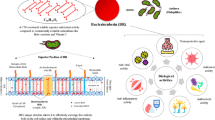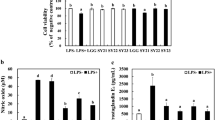Abstract
Fungal spoilage led to a considerable economic loss of foodstuff which ultimately affects public health due to mycotoxins production. Moreover, the consumption of commercial antifungal drugs creates side effects and develops antifungal resistance. To overcome these challenges, the current work was aimed to investigate novel antifungal cyclic dipeptide (CDP) from Lactobacillus coryniformis (Loigolactobacillus coryniformis) BCH-4. CDPs have flexible, cyclic, and stable conformation. The proline-based CDPs provide additional structural compatibility and bio-functional values. Keeping in view, high-performance liquid chromatography (HPLC) was performed to explore cyclo(L-Leu-L-Pro) from L. coryniformis BCH-4. The HPLC detected concentration (135 ± 7.07 mg/mL) exhibited in vitro antifungal activity of 5.66 ± 0.57 mm (inhibitory zone) against Aspergillus flavus. Based on these results, cyclo(L-Leu-L-Pro) was used as a bioprotectant for selected food samples (grapes, lemon, cashew nuts, and almonds). A significant impact of cyclo(L-Leu-L-Pro) was observed in contrast with MRS broth (control) and cell-free supernatant. In silico molecular docking analysis of this CDP was carried out against FAD glucose dehydrogenase, dihydrofolate reductase, and urate oxidase of A. flavus as target proteins. Among these proteins, FAD glucose dehydrogenase exerted strong interactions with cyclo(L-Leu-L-Pro) having S-score of – 8.21. The results evaluated that the detected CDP has strong interactions with selected proteins, causing excellent growth inhibition of A. flavus. Therefore, cyclo(L-Leu-L-Pro) could be used as a potent bioprotectant against food-borne pathogenic fungi.






Similar content being viewed by others
Abbreviations
- A. flavus :
-
Aspergillus flavus
- CDPs:
-
Cyclic dipeptides
- CFS:
-
Cell-free supernatant
- DHFR:
-
Dihydrofolate reductase
- DKP:
-
2,5-Diketopiperazines
- FAD:
-
Flavin adenine dinucleotide
- GRAS:
-
Generally recognized as safe
- L. coryniformis :
-
Lactobacillus coryniformis
- LAB:
-
Lactic acid bacteria
- MOE:
-
Molecular operating environment
- RMSD:
-
Root mean squared deviation
- THF:
-
Tetrahydro-folic acid
References
Abouloifa H, Gaamouche S, Rokni Y, Hasnaoui I, Bellaouchi R, Ghabbour N, Karboune S, Brasca M, D’Hallewin G, Salah RB, Saalaoui E, Asehraou A (2021) Antifungal activity of probiotic Lactobacillus strains isolated from natural fermented green olives and their application as food bio-preservative. Biol Control 152:104450
AOAC (1990) Official methods of analysis (13th edition). Association of Official Analytical Chemist, Washington DC, USA
Arif R, Ahmad S, Mustafa G, Mahrosh HS, Ali M, Tahir ul Qamar M, Dar HR (2021) Molecular docking and simulation studies of antidiabetic agents devised from hypoglycemic polypeptide-p of Momordica charantia. Biomed Res Int 2021:5561129
Asgher M, Qamar SA, Bilal M, Iqbal HM (2020) Bio-based active food packaging materials: Sustainable alternative to conventional petrochemical-based packaging materials. Food Res Int 137:109625
Azat R, Liu Y, Li W, Kayir A, Lin DB, Zhou WW, Zheng XD (2016) Probiotic properties of lactic acid bacteria isolated from traditionally fermented Xinjiang cheese. J Zhejiang Univ Sci B 17(8):597–609
Barcenilla C, Ducic M, López M, Prieto M, Álvarez-Ordóñez A (2022) Application of lactic acid bacteria for the biopreservation of meat products: A systematic review. Meat Sci 183:108661
Bashir O, Bhat SA, Basharat A, Qamar M, Qamar SA, Bilal M, Iqbal HM (2022) Nano-engineered materials for sensing food pollutants: Technological advancements and safety issues. Chemosphere 292:133320
Bilal M, Gul I, Basharat A, Qamar SA (2021) Polysaccharides-based bio-nanostructures and their potential food applications. Int J Biol Macromol 176:540–557
Bojarska J, Mieczkowski A, Ziora Z, Skwarczynski M, Toth I, Shalash AO, Parang K, El-Mowafi SA, Mohammed EHM, Elnagdy S, AlKhazindar M, Wolf WM (2021) Cyclic dipeptides: The biological and structural landscape with special focus on the anti-cancer proline-based scaffold. Biomolecules 11(10):1515
Bukhari SA, Salman M, Numan M, Javed MR, Zubair M, Mustafa G (2020) Characterization of antifungal metabolites produced by Lactobacillus plantarum and Lactobacillus coryniformis isolated from rice rinsed water. Mol Biol Rep 47(3):1871–1881
Crowley S, Mahony J, van Sinderen D (2013) Current perspectives on antifungal lactic acid bacteria as natural bio-preservatives. Trends Food Sci Technol 33(2):93–109
Cui CB, Kakeya H, Osada H (1997) Novel mammalian cell cycle inhibitors, cyclotroprostatins A-D, produced by Aspergillus fumigatus, which inhibit mammalian cell cycle at G2/M phase. Tetrahedron 53(1):59–72
Dal Bello F, Clarke CI, Ryan LAM, Ulmer H, Schober TJ, Ström K, Sjögren J, van Sinderen D, Arendt Schnürerc J (2007) Improvement of the quality and shelf life of wheat bread by fermentation with the antifungal strain Lactobacillus plantarum FST 1.7. J Cereal Sci 45(3):309–318
Dopazo V, Luz C, Mañes J, Quiles JM, Carbonell R, Calpe J, Meca G (2021) Bio-preservative potential of microorganisms isolated from red grape against food contaminant fungi. Toxins 13(6):412
Dopazo V, Luz C, Quiles JM, Calpe J, Romano R, Manes J, Meca G (2022) Potential application of lactic acid bacteria in the biopreservation of red grape from mycotoxigenic fungi. J Sci Food Agric 102(3):898–907
El Oirdi S, Lakhlifi T, Bahar AA, Yatim M, Rachid Z, Belhaj A (2021) Isolation and identification of Lactobacillus plantarum 4F, a strain with high antifungal activity, fungicidal effect, and biopreservation properties of food. J Food Process Preserv 45(6):e15517
El-Shershaby MH, El-Gamal KM, Bayoumi AH, El-Adl K, Alswah M, Ahmed HE, Al-Karmalamy AA, Abulkhair HS (2021) The antimicrobial potential and pharmacokinetic profiles of novel quinoline-based scaffolds: Synthesis and in silico mechanistic studies as dual DNA gyrase and DHFR inhibitors. New J Chem 45(31):13986–14004
Fahim AM, Farag AM (2020) Synthesis, antimicrobial evaluation, molecular docking and theoretical calculations of novel pyrazolo [1, 5-a] pyrimidine derivatives. J Mol Struct 1199:127025
Fazel R, Zarei N, Ghaemi N, Namvaran MM, Enayati S, Ardakani EM, Azizi M, Khalaj V (2014) Cloning and expression of Aspergillus flavus urate oxidase in Pichia pastoris. Springerplus 3(1):1–7
Hipólito A, da Silva RAA, de Oliveira Caretta T, Silveira VAI, Amador IR, Panagio LA, Borsato D, Celligoi MAPC (2020) Evaluation of the antifungal activity of sophorolipids from Starmerella bombicola against food spoilage fungi. Biocatal Agric Biotechnol 29:101797
Hussein MA, El-Said AH, Yassein AS (2020) Mycobiota associated with strawberry fruits, their mycotoxin potential and pectinase activity. Mycology 11(2):158–166
Ishola RO, Adebayo-Tayo BC (2012) Screening of lactic acid bacteria isolated from fermented food for bio-molecules production. AU J Technol 15(4):205–217
Khalil N, Dabour N, Kheadr E (2021) Food bio-preservation: an overview with particular attention to Lactobacillus plantarum. Alex J Food Sci Tech 18(1):33–50
Kim S, Thiessen PA, Bolton E, Chen J, Fu G, Gindulyte A, Han L, He J, He S, Shoemaker BA, Wang J, Bo YuB, Bryant SH (2016) PubChem substance and compound databases. Nucleic Acids Res 44(D1):D1202–D1213
Klich MA (2007) Aspergillus flavus: the major producer of aflatoxin. Mol Plant Pathol 8(6):713–722
Krejcarek GE, Dominy BW, Lawton RG (1968) The interaction of reactive functional groups along peptide chains; a model for alkaloid biosynthesis. Chem Commun (London) 22:1450–1452
Kumar SN, Mohandas C, Nambisan B (2013) Purification of an antifungal compound, cyclo (l-Pro-d-Leu) for cereals produced by Bacillus cereus subsp. thuringiensis associated with entomopathogenic nematode. Microbiol Res 168(5):278–288
Kumari PK, Akhila S, Rao YS, Devi BR (2019) Alternative to artificial preservatives. Syst Rev Pharm 10:99–102
Kwak MK, Liu R, Kwon JO, Kim MK, Kim AH, Kang SO (2013) Cyclic dipeptides from lactic acid bacteria inhibit proliferation of the influenza A virus. J Microbiol 51(6):836–843
Kwak MK, Liu R, Kim MK, Moon D, Kim AH, Song SH, Kang SO (2014) Cyclic dipeptides from lactic acid bacteria inhibit the proliferation of pathogenic fungi. J Microbiol 52(1):64–70
Larrigaudiere C, Pons J, Torres R, Usall J (2002) Storage performance of clementines treated with hot water, sodium carbonate and sodium bicarbonate dips. J Hortic Sci Biotechnol 77(3):314–319
Le Lay C, Coton E, Le Blay G, Chobert JM, Haertlé T, Choiset Y, Mounier J (2016) Identification and quantification of antifungal compounds produced by lactic acid bacteria and propionibacteria. Int J Food Microbiol 239:79–85
Lee JY, Kim CJ, Kunz B (2006) Identification of lactic acid bacteria isolated from kimchi and studies on their suitability for application as starter culture in the production of fermented sausages. Meat Sci 72(3):437–445
Magnusson J, Schnürer J (2001) Lactobacillus coryniformis subsp. coryniformis strain Si3 produces a broad-spectrum proteinaceous antifungal compound. Appl Environ Microbiol 67(1):1–5
Martins MB (2007) Diketopiperazines: biological activity and synthesis. Tetrahedron 63:9923–9932
McCleland K, Milne PJ, Lucieto FR, Frost C, Brauns SC, Van De Venter M, Dyason K (2004) An investigation into the biological activity of the selected histidine-containing diketopiperazines cyclo (His-Phe) and cyclo (His-Tyr). J Pharm Pharmacol 56(9):1143–1153
Mirza SK, Asema UK, Kasim SS (2017) To study the harmful effects of food preservatives on human health. J Med Chem Drug Discovery 2:610–616
Montesinos-Herrero C, del Río MÁ, Pastor C, Brunetti O, Palou L (2009) Evaluation of brief potassium sorbate dips to control postharvest Penicillium decay on major citrus species and cultivars. Postharvest Biol Technol 52(1):117–125
Muhialdin BJ, Algboory HL, Kadum H, Mohammed NK, Saari N, Hassan Z, Hussin ASM (2020) Antifungal activity determination for the peptides generated by Lactobacillus plantarum TE10 against Aspergillus flavus in maize seeds. Food Control 109:106898
Mustafa G, Mahrosh HS, Salman M, Sharif S, Jabeen R, Majeed T, Tahir H (2021) Identification of peptides as novel inhibitors to target IFN-γ, IL-3, and TNF-α in systemic lupus erythematosus. Biomed Res Int 2021:1124055
Ortiz A, Sansinenea E (2017) Cyclic dipeptides: secondary metabolites isolated from different microorganisms with diverse biological activities. Curr Med Chem 24(25):2773–2780
Palou L, Usall J, Smilanick JL, Aguilar MJ, Vinas I (2002) Evaluation of food additives and low-toxicity compounds as alternative chemicals for the control of Penicillium digitatum and Penicillium italicum on citrus fruit. Pest Manag Sci 58(5):459–466
Palou L, Smilanick JL, Droby S (2008) Alternatives to conventional fungicides for the control of citrus postharvest green and blue moulds. Stewart Postharvest Rev 2(2):1–16
Rana KM, Maowa J, Alam A, Dey S, Hosen A, Hasan I, Kawsar S (2021) In silico DFT study, molecular docking, and ADMET predictions of cytidine analogs with antimicrobial and anticancer properties. In Silico Pharmacol 9(1):1–24
Saithong P, Panthavee W, Boonyaratanakornkit M, Sikkhamondhol C (2010) Use of a starter culture of lactic acid bacteria in plaa-som, a Thai fermented fish. J Biosci Bioeng 110(5):553–557
Salman M, Tariq A, Ijaz A, Naheed S, Hashem A, Abdllah E, Javed MR (2020) In Vitro Antimicrobial and Antioxidant Activities of Lactobacillus coryniformis BCH-4 Bioactive Compounds and Determination of Their Bioprotective Effects on Nutritional Components of Maize (Zea Mays L). Molecules 25(20):4685
Sammes PG (1975) Naturally occurring 2, 5-dioxopiperazines and related compounds. Fortschr Chem Org Naturst 32:51–118
Ström K, Sjögren J, Broberg A, Schnürer J (2002) Lactobacillus plantarum MiLAB 393 produces the antifungal cyclic dipeptides cyclo (L-Phe-L-Pro) and cyclo (L-Phe-trans-4-OH-L-Pro) and 3-phenyllactic acid. Appl Environ Microbiol 68(9):4322–4327
Sussman JL, Lin D, Jiang J, Manning NO, Prilusky J, Ritter O, Abola EE (1998) Protein Data Bank (PDB): database of three-dimensional structural information of biological macromolecules. Acta Crystallogr D Biol Crystallogr 54(6):1078–1084
Valencia-Chamorro SA, Perez-Gago MB, Del Rio MA, Palou L (2009) Curative and preventive activity of hydroxypropyl methylcellulose-lipid edible composite coatings containing antifungal food additives to control citrus postharvest green and blue molds. J Agric Food Chem 57(7):2770–2777
Vilar S, Cozza G, Moro S (2008) Medicinal chemistry and the molecular operating environment (MOE): application of QSAR and molecular docking to drug discovery. Curr Top Med Chem 8(18):1555–1572
Yang E, Chang H (2010) Purification of a new antifungal compound produced by Lactobacillus plantarum AF1 isolated from kimchi. Int J Food Microbiol 139(1–2):56–63
Yoshida H, Sakai G, Mori K, Kojima K, Kamitori S, Sode K (2015) Structural analysis of fungus-derived FAD glucose dehydrogenase. Sci Rep 5(1):1–13
Funding
This study was funded by Higher Education Commission, Pakistan under Government College University Faisalabad-Research Support Program (GCUF-RSP), award letter no. GCUF/Reg/17/3655 and project code: 19-ACH-19.
Author information
Authors and Affiliations
Corresponding authors
Ethics declarations
Conflict of interest
The authors declared no conflict of interest.
Additional information
Communicated by Erko Stackebrandt.
Publisher's Note
Springer Nature remains neutral with regard to jurisdictional claims in published maps and institutional affiliations.
Rights and permissions
About this article
Cite this article
Salman, M., Tariq, A., Mustafa, G. et al. Cyclo(L-Leucyl-L-Prolyl) from Lactobacillus coryniformis BCH-4 inhibits the proliferation of Aspergillus flavus: an in vitro to in silico approach. Arch Microbiol 204, 267 (2022). https://doi.org/10.1007/s00203-022-02884-z
Received:
Revised:
Accepted:
Published:
DOI: https://doi.org/10.1007/s00203-022-02884-z




